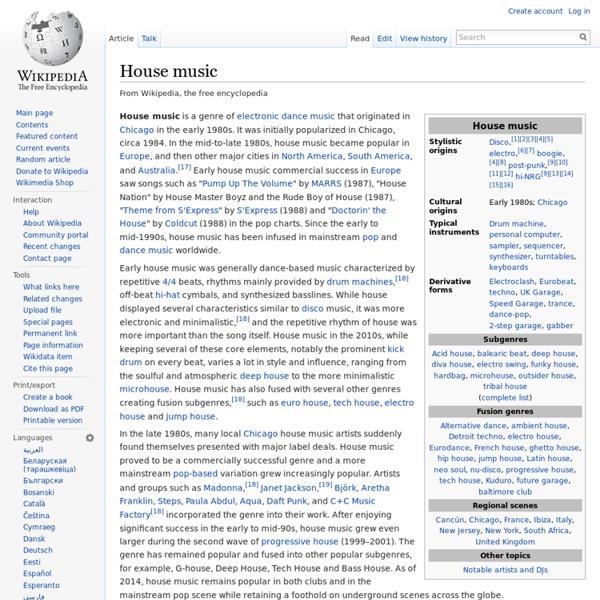DJ Shadow
Joshua Paul "Josh" Davis (born June 29, 1972),[1][2] better known by his stage name DJ Shadow, is an American music producer and DJ. He is a prominent figure in the development of instrumental hip hop and first gained notice with the release of his highly acclaimed debut album "Endtroducing.....". He has an exceptionally large personal record collection, with over 60,000 records.[3] He is the cousin of singer and guitarist Richie Kotzen. History[edit] Early years[edit] Also in 1993, Mo' Wax's James Lavelle contacted Shadow about releasing "In/Flux" on the fledgling imprint. Endtroducing..... Shadow's first full-length work, Endtroducing....., was released in late 1996 to critical acclaim. Preemptive Strike[edit] Dark Days[edit] The Private Press[edit] In Tune and on Time[edit] In 2004, Shadow's first feature-length DVD, In Tune and on Time, was released. The Outsider[edit] In 2006, he signed a deal with Universal Records. Diminishing Returns[edit] The Less You Know, the Better[edit]
Common (rapper)
with Mos Def 1999 As documented by hip hop journalist Raquel Cepeda, in the liner notes for the album, this event had a profound spiritual and mental effect on Common and enabled him to grow musically while becoming more responsible as an artist. She writes: Rashid found out that he was going to become a daddy in about 8 months. Common addresses family ethics several times on One Day..., and the album sleeve is decorated with old family photos, illustrating the rapper's childhood, as well a quote from 1 Corinthians 13:11, which summarizes the path to manhood: Performing at Store Vega, Copenhagen, Denmark in December 2007.
Electronic dance music
Electronic dance music (also known as EDM, dance music,[1] club music,[2] or simply dance) is a broad range of percussive electronic music genres produced primarily for dance-based entertainment environments such as nightclubs, raves, and festivals. The music is largely produced for playback by disc jockeys (DJs) and is generally used in the context of a live DJ mixes where the DJ creates a seamless selection of tracks by segueing from one recording to the next.[3] The term "electronic dance music" and the acronym "EDM" was adopted by the U.S. music industry and music press as a buzzword to describe the increasingly commercial American electronic music scene that developed in the 2000s. In this context, EDM does not refer to a specific genre, but is an umbrella term for a number of popular genres, including house, dubstep, trance, and trap.[4][5][6] History[edit] Acid house and Rave[edit] North American commercialization of EDM[edit] Criticism of commercial EDM[edit] Terminology[edit]
Roger Sanchez
Roger Sanchez (born on June 1, 1967) is an American (of Dominican descent) house music DJ. He is the eldest of two sons (his younger brother is named Gabriel) born to Angela Almonte and Hugo Rene Sanchez, immigrants from the Dominican Republic. Sanchez graduated from the High School of Art and Design in New York City. He attended Pratt Institute, working towards a degree in architecture, but took his father's advice to take a break from his studies to devote his full energy to DJing and see if he could make a career of it. Eventually he found success and began to play nightclubs in New York City, and later around the world. On October 28, 2009, DJ Magazine announced the results of their annual Top 100 DJ Poll, with Ultra Records Sanchez placed at number 60.[2] Roger is also the founder of his own label in 2002, Stealth Records. Awards[edit] At the 45th Grammy Awards in 2003, Sanchez won his first award for Best Remixed Recording for his remix of No Doubt's "Hella Good". Discography[edit]
: Urge Overkill :
Music genre
A music genre is a conventional category that identifies pieces of music as belonging to a shared tradition or set of conventions.[1] It is to be distinguished from musical form and musical style, although in practice these terms are sometimes used interchangeably.[2][not in citation given] Among the criteria often used to classify musical genres are: the trichotomy of art, popular, and traditional; time period; regional and national origins; technique and instrumentation; fusional origins; and social function.[citation needed] The art/popular/traditional distinction[edit] Musicologists have sometimes classified music according to a trichotomic distinction such as Philip Tagg's "axiomatic triangle consisting of 'folk', 'art' and 'popular' musics".[6] He explains that each of these three is distinguishable from the others according to certain criteria.[6] Art music[edit] Popular music[edit] Main article: Popular music Traditional music[edit] Critics of the axiomatic triangle[edit] See also[edit]
Rednex
History 1994-1999: formation, and Cotton Eye Joe Formation and Rednex name Cotton Eye Joe, and first album Band members (1990s) 2007-2008 Rednex lineup of (left to right) Anders "Maverick" Lundström, Annika "Mary Joe" Ljungberg, and Jens "Snake" Sylsjö. The founding Rednex line-up, featured in the video of Cotton Eye Joe, comprised characters Mary Joe (aka Karin Annika Ljungberg, who sang most of the female vocals on Sex & Violins), Ken Tacky, Bobby Sue, Billy Ray and Mup (aka Pat Reiniz). In 1996, lead female vocalist Mary Joe was sacked, partly due to disagreements with the other band members, and went on to pursue a solo career. Whippy (aka Mia Löfgren) became the new female vocalist in 1998. 2000-2004: band restructure, and new line-ups Second album, and single releases Greatest hits album, and Cotton Eye Joe remix In 2002, the band released a greatest hits album, The Best of the West, including previous hits plus new material. Band members (2000-2004) New management Proposed sale of Rednex
Teklife
Freebie from the Teklife family. To mark the release of a new compilation, Chicago-based footwork collective Teklife have offered up a freebie in the shape of 'Luchini VIP'. Veterans DJ Rash [...] Teklife’s DJ Earl drops the restrained Ambient EP The brand new five-tracker is out today on Footwork Frenzy.



